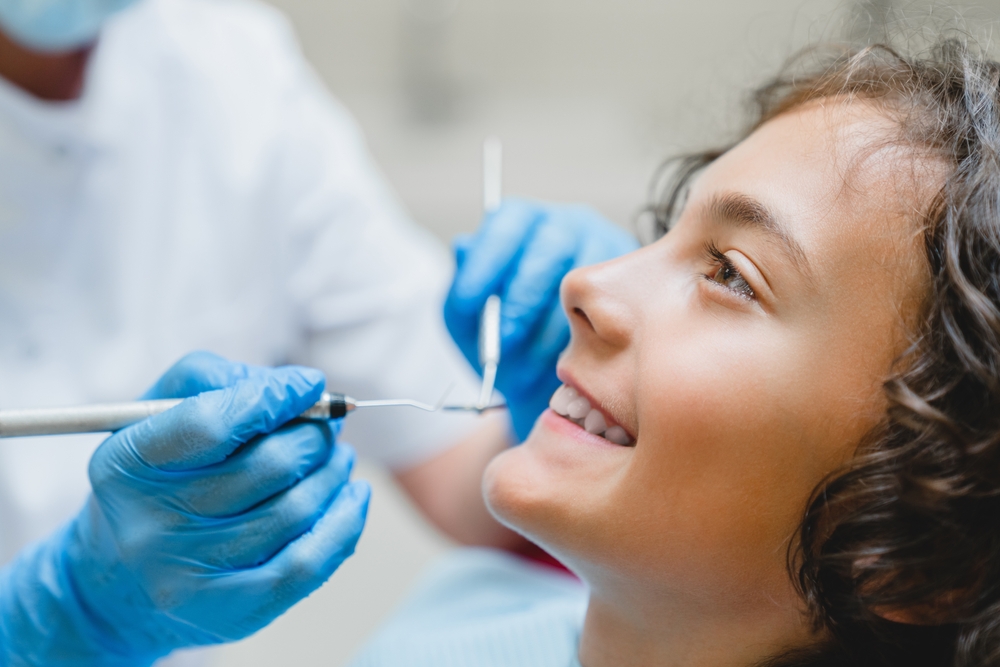The smooth surfaces of your kiddo’s teeth are easy to clean. In fact, their saliva naturally washes away a lot of the food debris and plaque throughout the day. The chewing surfaces of a child’s molars and premolars, however, are a different story.
While the pits and grooves found on these teeth help with chewing, they also trap food and plaque and make removing it more challenging. That’s why the back teeth are the most susceptible to cavities. Thankfully, dental sealants are extremely effective for stopping food bits, bacteria and acids from getting comfy in the nooks and crannies and causing tooth decay.
In this post, I’ll walk you through what sealants are, how they work and why kids should get them.
What are Dental Sealants?
Dental sealants essentially seal out cavities. A thin coating is brushed onto the chewing surfaces of the molars and, sometimes, the premolars too. The material bonds with the enamel and creates a protective barrier that stops food debris, plaque and cavity-causing acids from settling into the pits and grooves of the teeth.
What are dental sealants made of? Typically, dental sealants are made of a plastic resin material, though there are other types as well.
How Do Dental Sealants Work?
Whenever your child (or anyone!) eats or drinks, plaque bacteria feed on the sugars and starches and release acids. These acids erode the tooth enamel and can cause tooth decay. As tooth decay progresses, a hole may eventually form in the tooth. The hole is what we call a cavity.
As I said, sealants prevent food from getting stuck in the pits and grooves of the back teeth. They also serve almost like a force field, stopping bacteria and acids from penetrating the enamel and causing decay.
According to the Centers for Disease Control (CDC), dental sealants can prevent up to 80% of cavities in the back teeth, where 9 in 10 cavities occur. In fact, kids ages 6-11 without sealants, have nearly three times more cavities in their first molars than kids with sealants.
When Should Kids Get Dental Sealants
It’s rare that dental sealants are used on baby teeth and, instead, they’re usually reserved for the permanent teeth in the back of the mouth. At Smile Valley Pediatric Dentistry in DC, my team and I recommend kids get sealants as soon as their first permanent molars, also known as the 6-year molars, and their second permanent molars, known as the 12-year molars, erupt. By sealing the chewing surfaces of these teeth right away, we can stop cavities from the get-go.

How are Dental Sealants Applied?
When applying sealants, I start off by showing the patient the tools I’ll be using, demonstrating the tools for them and describing exactly what I’ll be doing during every step. This puts kids at ease and helps them to relax.
When the patient is ready, I clean and dry their teeth. I apply an etching solution to the teeth to roughen up the surface a bit so that the dental sealant material will stick. I rinse the solution off, dry the teeth again and paint the sealant material onto the chewing surfaces of the teeth. Finally, I harden the sealant with a special light and, that’s it, the child’s back teeth are now protected.
Dental sealants can last for years. During dental exams and cleanings, I always check any sealants. If I spot chips or damage, I can quickly repair them.
What are the Benefits of Dental Sealants?
- The biggest benefit of dental sealants is that they’re super effective at reducing the risk of cavities in kids’ back teeth.
- By keeping cavities away, sealants also prevent the need for more invasive, expensive treatment, saving you time and money.
- Applying dental sealants only takes about 15 minutes and is well-tolerated by the majority of kids.
- Getting sealants is painless and there are no needles involved!
- While the dental sealants cost depends on how many teeth we’re sealing, the treatment is affordable. Sealants cost much less than restoring a decayed tooth.
Are Dental Sealants Safe for Kids?
Yes! Dental sealants are safe for kids. Getting sealants is quick, painless, doesn’t require anesthesia or needles and there are no side effects.
Cavities, on the other hand, are one of the most common chronic diseases of childhood and can lead to pain, infection and even tooth loss. Oral health problems may impact a child’s self-esteem, ability to concentrate in school and even limit the foods they’re able to eat.
But What About the Dental Sealants Controversy I Read About?
There was a dental sealants controversy reported in the media about concerns over dental sealants containing bisphenol A, or BPA. And, yes, some plastic resin sealants contain miniscule amounts of BPA. While I do want to address the controversy and any worries parents might have, we actually use BPA-free sealants here at Smile Valley.
But, regardless, the truth is, the amount of BPA exposure is negligible and only occurs within the few hours after sealant application. As the American Dental Association states, the tiny amount of BPA in certain sealants is, “not enough to cause you or a loved one any harm. In fact, you get more exposure to BPA by simply touching a receipt, using cosmetics or coming in contact with dust.”
There is no scientific evidence that supports the idea that dental sealants are harmful, while there is overwhelming evidence supporting their benefits and ability to prevent tooth decay in children.
The Bottom Line
As a Washington, DC pediatric dentist and a mom, I can tell you sealants are absolutely worth it.
The simple, affordable procedure can prevent up to 80% of cavities in a child’s back teeth. Plus, I can apply sealants during one of your child’s routine cleanings and exams, saving you a trip to the office. There are plenty of benefits of dental sealants and no real drawbacks.
Is Your Child Ready for Dental Sealants in Washington, DC? If you think your child is ready for dental sealants, schedule an appointment at Smile Valley Pediatric Dentistry in Spring Valley, DC. With exceptional care and stress-free service, the Smile Valley team makes maintaining your child’s oral health fun and convenient.











